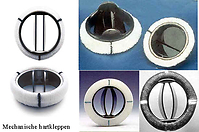Art Valves: Difference between revisions
Jump to navigation
Jump to search
(Created page with "==Different types of valve art== Before starting with echocardiographic evaluation of a valve prosthesis it is necessary to be aware of the different types of valve prosthese...") |
No edit summary |
||
| Line 3: | Line 3: | ||
Before starting with echocardiographic evaluation of a valve prosthesis it is necessary to be aware of the different types of valve prostheses. There is a difference in the kind and in the type and diameter. Thus, each manufacturer has its own characteristics. And there is a difference in whether the prosthesis is biologically or mechanically created. | Before starting with echocardiographic evaluation of a valve prosthesis it is necessary to be aware of the different types of valve prostheses. There is a difference in the kind and in the type and diameter. Thus, each manufacturer has its own characteristics. And there is a difference in whether the prosthesis is biologically or mechanically created. | ||
Click [Mechanical|here] for normal mechanical prosthesis | Click [[Mechanical|here]] for normal mechanical prosthesis | ||
Click [Biological|here] for normal biological prostheses | Click [[Biological|here]] for normal biological prostheses | ||
{| class="wikitable" cellpadding="0" cellspacing="0" border="0" width="500px" | |||
|- | |||
|[[Image:Mechkunstkleppen.jpg|300px]] | |||
|- | |||
!Mechanical prosthetic valves | |||
|} | |||
{| class="wikitable" cellpadding="0" cellspacing="0" border="0" width="500px" | |||
|- | |||
|Advantages and disadvantages of mechanical and bioprosthetic | |||
|- | |||
! | |||
!Mechanical | |||
!Biological | |||
|- | |||
!Benefits | |||
|Durable | |||
| | |||
*No anticoagulation needed | |||
*Less obstruction of the blood flow | |||
*No Leakage | |||
*Inaudible | |||
*Hemodialysis | |||
*Less risk of infection in the ring or edge flap | |||
*No pannus (tissue ingrowth) | |||
disadvantages | |||
|- | |||
!Anticoagulation needed | |||
| | |||
*Any obstruction of the blood flow | |||
*Leakage (leakage backflow after valve closure, closure backflow flap for closure. | |||
*Audible (ticks). | |||
*Hemodialysis (blood cells break down by colliding with mechanical valve. | |||
*Infection in ring or rim valve (endocarditis). | |||
*Pannus (tissue ingrowth) | |||
|Degeneration is 10-15 years | |||
|- | |||
!NB: For all valve prostheses is indicated in some cases endocarditis prophylaxis. | |||
|} | |||
==References== | ==References== | ||
Revision as of 21:54, 28 December 2013
Different types of valve art
Before starting with echocardiographic evaluation of a valve prosthesis it is necessary to be aware of the different types of valve prostheses. There is a difference in the kind and in the type and diameter. Thus, each manufacturer has its own characteristics. And there is a difference in whether the prosthesis is biologically or mechanically created.
Click here for normal mechanical prosthesis
Click here for normal biological prostheses

|
| Mechanical prosthetic valves |
|---|
| Advantages and disadvantages of mechanical and bioprosthetic | ||
| Mechanical | Biological | |
|---|---|---|
| Benefits | Durable |
disadvantages |
| Anticoagulation needed |
|
Degeneration is 10-15 years |
| NB: For all valve prostheses is indicated in some cases endocarditis prophylaxis. |
References
- Baumgartner H, Hung J, Bermejo J, Chambers JB, Evangelista A, Griffin BP, Iung B, Otto CM, Pellikka PA, Quiñones M, and EAE/ASE. Echocardiographic assessment of valve stenosis: EAE/ASE recommendations for clinical practice. Eur J Echocardiogr. 2009 Jan;10(1):1-25. DOI:10.1093/ejechocard/jen303 |
- Lancellotti P, Tribouilloy C, Hagendorff A, Moura L, Popescu BA, Agricola E, Monin JL, Pierard LA, Badano L, Zamorano JL, and European Association of Echocardiography. European Association of Echocardiography recommendations for the assessment of valvular regurgitation. Part 1: aortic and pulmonary regurgitation (native valve disease). Eur J Echocardiogr. 2010 Apr;11(3):223-44. DOI:10.1093/ejechocard/jeq030 |